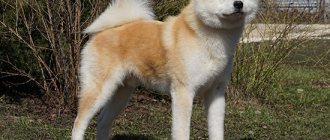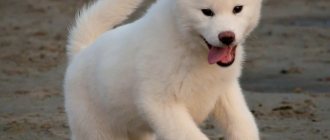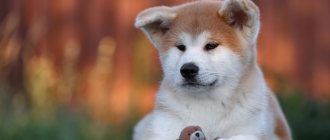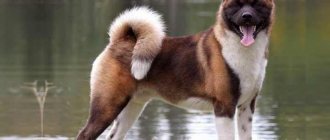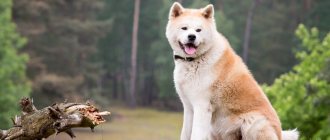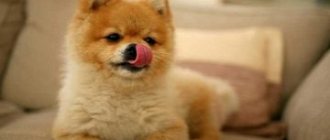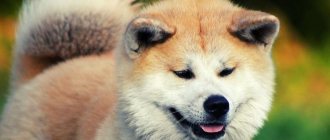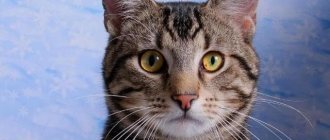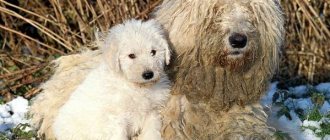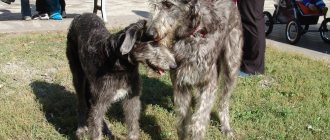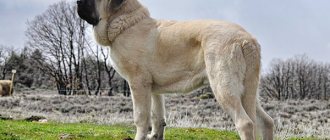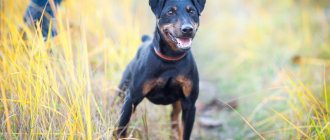Origin story
The ancestors of the American Akita are Japanese dogs from the Akita region.
In their homeland they took part in dog fights. After fighting was banned (1908), the breed began to develop as a large Japanese dog. During World War II, she had a hard time - dog skins were used to sew warm clothes and for other economic purposes. There have been attempts to save the breed by crossing it with the German Shepherd. After the war, the breed began to revive. Her journey across the continents began. American soldiers returned home and took with them cute dogs that looked like big teddy bears. This is how the Akita came to the USA and began to be called American. In Japan, Akitas developed according to their own canons, in the USA - according to their own. Later, these two varieties were separated into separate breeds.
The ancestors of representatives of this breed were among the first to live near people for a long time. This fact is confirmed by cave paintings made 500 BC. e. In those ancient times, similar dogs were reliable guards and assistants in hunting large animals. Later they received the name Akita Inu.
American dogs, whose ancestors were these ancient animals, appeared much later. They were bred during World War II, when the Akita Inu was in danger of extinction. To preserve the existing population, the remaining dogs began to be crossed with mastiffs and German shepherds. Puppies born from such matings subsequently came to the USA and aroused serious interest among local breeders.
They were considered rare and very valuable animals. For a long time they were not separated from Japanese dogs in any way. But then it became clear to professionals how different these animals are from each other. Therefore, in 2000, an official decision was made to divide these dogs into Akita Inu and American Akita. The latter has another name. It is also known as the large Japanese dog.
Akita character
A Japanese dog can become a companion for its owner. Animals, due to their powerful equipment, are very strong, hardy and strong. A characteristic feature of the breed is courage, consistency, and independence.
This is interesting: 9 breeds of Japanese origin
The animal performs guard work well. A guard dog will never give a voice if intruders do not try to get inside the protected area.
The American Akita is also an excellent hunter. Good sense of smell, hearing, and vision provide the dog with the ability to track a target in difficult weather conditions.
These animals love to play and quickly become attached to their owner. Akita is good with children, but may be suspicious of new people in the family.
Expert opinion
Anna Abramenko
An avid dog lover. Experience in veterinary medicine since 2009.
Ask a Question
Dogs love snow very much, they are able to pull sleighs with children and happily ride in snowdrifts.
The attitude towards other animals is dominant. This breed prefers to be the only pet in the family. Therefore, if you get another pet, be it a cat or a dog, the Akita may become jealous and show aggression.
The benefits of professional training
By analogy with other giant breeds, an American Akita puppy must understand from the first days who is boss in the house. How to achieve this:
- When raising an American puppy under two months of age, the owner must make every effort to properly adapt the American puppy to the outside world. Daily training lessons on getting used to your place, using a diaper, contacts with family members should take place in a good-natured atmosphere.
- It is better to raise a dog in a private house in Moscow, where there is a plot. In an apartment, an adult Akita will feel cramped, and she needs a lot of space.
- Short-term walks during training begin first on their own territory, gradually adapting the American puppy to the street and meetings with relatives. It is desirable that the dogs are well-mannered and calm.
- By the age of three months, training begins to carry out service commands “sit/lie down”, “place”, “fu/no”. The puppy may be distracted and tired from activities. You need to patiently, day after day, repeat the exercises, using play manipulations, rewarding with treats when fully working out the commands during training.
- The main secret of upbringing lies in the attitude of the owner himself to become a friend and leader, to persistently and with interest spend training time with the American pet, and he feels this well. You need to completely reorganize yourself into restraint and affection, not use force, not shout and not punish with lack of attention during training.
At 3-4 months, walk the Akita with a leash, teach it to walk nearby, not chew the rope, and not show aggression towards other people’s animals. When playing with dogs, be in complete control of behavior. It should not be embarrassing that the animal barks little. This is an American silent breed that thinks and analyzes more. Barking can only occur when there is a real threat.
From six months of training to a year, the most important stage of education begins. In addition to training in following commands, the Akita needs to develop strength and endurance. You will have to devote a lot of energy to running and strength exercises. Here it is best to use the assistance of experienced dog handlers.
Specialized organizations for service training of American hunting and guard breeds have strong advantages over home education.
Dog handlers, as multifunctional specialists, will conduct courses on interaction with the dog for the owner himself:
- during training, scientific methods are used that have been proven over the years and are highly effective in a short period of time;
- the specialist will select a corrective course individually for each Akita, taking into account its characteristics of the nervous system and habits;
- students of cynological schools always have support in matters of health, finding a mate and mating, and caring for offspring;
- if the owner wants to prepare the dog for exhibitions, the pet will undergo special courses for the ring with its handler.
The canine training center in Moscow provides high-quality training at specialized sites, unique training and education courses. With the help of experienced dog handlers, special techniques will be used to identify the valuable natural skills of the American breed, which will benefit the dog and its owner.
- walk obediently next to the owner, both with and without a leash;
- when the owner stops, the pet will also stop and sit next to him without an additional command;
- carry out commands both near the owner and at a distance;
- execute commands when the owner uses only gestures;
- behave patiently in any position for a long time;
- on the command “come to me!” approach the owner immediately in any situation;
- always follow the command “to your place!” ;
- execute the command “Aport!” and bring any items;
- immediately execute the command “fu!” ;
- do not react to loud sounds on the street: traffic noise, siren sounds, gunshots and other loud sounds.
Before you get a cute puppy, you need to know how to raise an American dog. This is a breed that needs to be negotiated with. They say she needs a firm hand, but with a soft glove. The dog will not follow the same commands if he does not see the point in them. You shouldn’t take him to the site for a training course (OCD) if you don’t know what to do there. He won’t understand why he needs to carry out the same commands day after day. The “stick” method also does not work; it is better to use the “carrot”.
The most difficult period for a dog is growing up. Training an American Akita during puberty requires special skills. The puppy has attacks of superiority over people. How you go through this period will determine who will be the boss in your house. You don’t need to raise your voice often at your Akita, and you shouldn’t hit him at this time. But if a grown-up puppy opens its mouth at its owner, you need to grab it by the lower jaw and hold it until the pupil realizes his guilt.
The genes of this breed have a desire to protect the owner. This is the nature of the American Akita. Therefore, special attention should be paid to the “Place” command. Otherwise, the dog will sleep by your bed, wait under the kitchen door and watch all your movements around the house. Important commands are also “Near”, “To me”. If the dog has not yet mastered them, do not let him off the leash on the street.
The American Akita is a dog with a highly developed sense of self-esteem. Therefore, before you start training, you need to establish good contact with your ward. It is important that the dog trusts and respects its owner. Then the learning process will be very easy.
It is advisable to start training after the puppy has completely settled into his new home and gets used to the people around him. The first thing a baby should learn is his name. It should be short, sonorous and easy to remember for the dog. The American Akita's nickname usually consists of two or three syllables and reflects the character or external features of the dog.
Representatives of this breed are not those who like monotonous activities. Therefore, their training should take place in a playful way. Having noticed that the puppy has begun to lose interest in activities, he needs to be distracted with a toy or treat. It is also important that the education of the American Akita (a photo of the dog can be seen in today’s article) is consistent and systematic.
Basic commands
You will use some commands more often, others less often. But they will still come in handy to easily interact with the American Akita Inu and even keep him safe in various situations.
- Aport. One of the most difficult teams. Many people perceive it as very easy and simple, but with many dogs you will have to work hard. This skill is used for other exercises: searching, searching, selecting an item and many others. Usually they are all used in service. When working out a command, “Aport” and “Give” are used, and a gesture is also used.
- Give. On the command “Give” the dog must give up the object.
- Lie. A connecting command that needs to be learned for other commands. In addition, it will not interfere at home or on the street.
- To me. You will need to use this command quite often. So start with it immediately after your American Akita Inu puppy has learned his name. Never call the dog to punish, and do not scold if it comes on its own, even after mischievousness before it. This behavior on your part may alienate the animal.
- Place. A puppy or an adult dog must clearly know where his place is located. He can sleep anywhere, if you allow it, of course, but he must know this command. You can use it outside the home, marking the place with a leash or your favorite toy.
- Near. It is possible to teach your pet the “Near” command at any age, be it an adult dog or a small puppy. When you move to a new home, you should immediately think about training your puppy.
- Sit. One of the very first commands that an American Akita Inu puppy should learn.
- Stand. The command is useful in everyday life, for example, for combing a dog.
- . The prohibiting command is one of the most mandatory and taming it begins from the first day the puppy appears in the house. Requiring the command “Fu!”, “No!”, “No!” - immediately stop the unwanted action.
Who is this dog suitable for?
The owner of an American Akita can be a person who already has experience with dogs. Willful and self-confident handsome men need a strict and demanding owner who can force them to obey his will. A newcomer is unlikely to be able to become an indisputable authority for them. This means that there is an increased likelihood that in his hands, a cute funny puppy will grow into an undisciplined, poorly controlled and hooligan dog that brings nothing but problems.
We suggest you read: Border Collie breed description
Since the American Akita (a large Japanese dog) does not tolerate loneliness well and needs constant communication with people, it should not be owned by those who spend a lot of time at work and will not be able to pay enough attention to their pet. Its owner should be an active person with a free schedule.
Also, people with an impatient and explosive character should not get a large Japanese dog that is too soft or, on the contrary, cruel. A potential Akita owner must be the epitome of self-control, perseverance and perseverance.
Description
Representatives of this breed have a memorable exterior. These are massive, big-boned dogs with well-developed muscles, a cute bear-like muzzle and pronounced sexual dimorphism. Males are much taller and heavier than American Akita females. The weight of an adult dog can reach 32-60 kg with a height of 60-70 cm at the withers.
On a round, heavy head with a short muzzle, a flat forehead, a smoothly curved nape, a straight bridge of the nose and prominent cheekbones, there are small triangular eyes with a characteristic squint and neat erect ears. The strong jaws have large white teeth hidden under thick black lips. As for the bite, it can be scissor- or pincer-shaped.
The American Akita is a rectangular dog. Under a slightly elongated body with a straight, strong back, a wide, voluminous chest and a massive croup, there are two pairs of strong, even, stocky limbs with heavy but harmonious joints, rounded paws, thumbs and elastic, thick-skinned pads.
Description of the breed
In the external features of the American Akita, one can easily discern its Japanese ancestor - the Akita Inu. They share common features of the muzzle, head and body. However, despite such a close family connection, it is immediately apparent that the American representatives of the breed primarily differ from the Japanese:
- much more impressive dimensions;
- spotted colors and other shades of wool;
- the shape of the head, which in American Akitas is somewhat larger and wider than in Japanese ones.
The American Akita has an impressive size
The height of these dogs at the withers according to the breed standard should be:
- for males - 72 centimeters;
- for females - 67 centimeters.
The dog has wide bones and well-developed muscles. The weight of American Akitas is 25-30 kilograms higher than that of their Japanese ancestors! So, the following indicators are characteristic:
- for Akita Inu, the maximum body weight can be 45 kilograms;
- For the American Akita, the maximum possible body weight is 70 kilograms.
As for the nuances and parameters of the exterior, the American Akita has the following characteristics.
Table 1. Exterior of the American Akita
| Parameter | Characteristic |
| Eyes | The eyes of dogs of this variety can be described as small in size. The iris is usually brown, the shades within it may vary |
| Nose | American Akitas have a standard black or dark brown nose. If white predominates in the color of the animal, then the nose may also be a slightly lighter brown shade; this is not considered a defect in the breed |
| Ears | The ears of these dogs are small. Relative to the head, they are located in a vertical position, while slightly tilted towards the animal’s nose |
| Neck and head | The animal's head is large and wide. The frontal lobe protrudes noticeably forward, having a prominent junction. The animal's neck is very developed and muscular |
| Limbs | The paws of American Akitas are large, muscular and even sinewy. They are located clearly parallel to each other. The pads on the limbs of animals are fleshy, the ends of the paws are large |
| Tail | The tail is evenly covered with fluffy hair throughout its entire length, while it itself is of medium length. Its shape is ring-shaped, it looks like a real decoration of this animal |
Akita's beautiful chocolate eyes are mesmerizing
Wool
The coat of these dogs is very pleasant to the touch, thick and soft due to the abundantly growing undercoat. It is straight in structure. The entire body is the same length, with the exception of some places where it is slightly shortened:
- heads;
- paw
However, the specific length in millimeters for wool has not been determined; this parameter may vary.
The colors can be absolutely any. However, there is a condition: if there are spots on the dog’s body, then they must have a clear demarcation from the other color areas. The coloring should be uniform, with a discrepancy between the colors of the undercoat and the long coat allowed.
Please note an interesting fact: in total, US breeders bred two variants of the American Akita:
- dogs with standard long hair;
- dogs with long hairs.
Long-haired Akita is a long-haired variety of the breed.
Representatives of the second variety have longer fur, as you already understood, due to which “pants” are formed on its paws. In addition, due to this interesting feature, animals look much more voluminous and fluffier:
- tail;
- ears.
Interestingly, this mutation is not a deviation from the breed standard, but in itself it is a genetic failure. So, for example, if you own two ordinary American Akitas, their litter may well produce a fluffy puppy like this.
Longhaired American Akita
This is a thick-skinned and very beautiful dog. The American Akita, which is difficult to describe in a couple of short paragraphs, has a voluminous soft undercoat hidden under a hard, slightly bristling awn. The hair on the tail, rump, scruff and body is longer than on the limbs, ears and muzzle.
As for the color, it can be almost anything. But the most common species are spotted, brindle, straw, red and white. Most representatives of this breed have a dark mask on their faces. Often the color of the undercoat is slightly different from the tone of the guard hair.
A long-haired individual can appear in almost any litter. But I must say, this does not happen so often. The reason for this phenomenon is a gene that may not appear in the phenotype of dogs for a long time. The probability increases to 25% if both producers are carriers of the gene. The appearance of such pets is considered by many to be even more attractive than that of standard representatives of the breed. The longhaired variety of the breed has longer hair on the ears, tail, face and paws, and forms “pants” on the limbs.
Breeders note that Longnecks are devoted pets without signs of aggression. However, long hair is more difficult to care for and requires regular brushing. And an exhibition career is not for these impressive beauties. They are rejected in the rings, and breeders often sell such puppies as breeding marriages, making a corresponding note in the pedigree. Longtails are also not allowed for breeding.
Rules for the care and maintenance of the American Akita
Content
Despite the difficulties associated with upbringing, the Akita is a very comfortable and unpretentious dog. She can live not only on the territory of a large private house. Yes, she:
- fits comfortably in a relatively small apartment or other type of urban housing;
- very clean;
- does not smell like “dog”;
- has thick fur, which allows it to also live outdoors under the scorching sun and at low temperatures.
However, it must be taken into account that physical activity is the key to the health of American Akitas. So, if your pet lives in an apartment with you, you should walk it:
- at least three times a day;
- each walk lasts one and a half to two hours.
American Akitas need to be walked at least two to three times a day for several hours.
At the same time, we are not talking about calmly wandering along the streets of the city. These dogs need active games with their owners, therefore, we advise you to take for walks:
- cords;
- balls;
- frisbee and other devices for playing with animals.
Dogs living outside your home will also want to play with you, but it’s a little easier for them, because they are outside all day.
An important point: if you don’t spend enough time walking your dog, it will decide that it doesn’t have enough freedom and movement and will run away. Unfortunately, such an incident is not uncommon with this breed, since, despite warnings, people acquire its representatives and then devote insufficient time to them.
So, residents of private houses will have to take care of a high fence, which will also be dug into the ground by about half a meter or a meter. This is necessary for the dog to:
- couldn’t jump over it;
- I couldn’t make a tunnel and escape through it.
Be careful: dogs of this breed are prone to escape and short-term wandering
Attention must also be maintained while walking. Some obstinate Akitas specifically break out of their collars and run wherever they look. Believe me, you won’t be able to catch up with them, and passers-by are unlikely to decide to help you catch such a muscular and very serious-looking animal.
Care
As for caring for these dogs, it should be noted that it is very simple. So, animal fur, for example, you need:
- comb once a month to remove undercoat and massage the skin;
- increase the amount of combing during shedding;
- bathe once every six months.
Provided that your pet has a pedigree and regularly attends exhibitions, then it is best to have its coat taken care of in professional grooming salons - dog beauty salons.
Cleaning and combing the coat is an extremely important aspect of dog care.
This is how they tidy up not only the coat, but also other elements of the animal’s body that require increased attention:
- teeth that need to be regularly brushed with a brush and paste, removing accumulated food debris from the gum sinuses and removing plaque;
- ears, in which wax accumulates, which must be removed, and hair grows, which also needs to be plucked;
- claws that, in the absence of natural grinding, need to be cut off.
You must also take care of these parts of the body yourself. So, it is better to clean the ears once every two weeks, the teeth once every two days, and the claws are trimmed as they grow using specialized nail clippers.
Thanks to their fur, Akitas can live in the snow.
Character of the American Akita
Male:
Bitch:
Price:
Lifespan: 10–12 years. |
Is it difficult to care for | Grooming is simple, the only difficulty is combing the fur during the molting period. |
Where is the best place to keep it? | They can be kept in an apartment, but an aviary is considered ideal. |
What climate do they prefer? | They do not like heat; when kept in an apartment, it is necessary to provide free access to the balcony and air conditioning in the summer. |
How often should you bathe? | They bathe rarely, as needed. Exhibition animals - before each event. |
Are there any problems with catering? | The pet eats a little and is not prone to overeating. However, high quality feed is required. |
How long should walks be? | They walk twice a day for at least an hour. Walking is preferred. |
Is it normal for the American Akita to have long hair? | A person with long hair is called a long-haired Akita. This feature is considered the result of a genetic failure. The dogs look impressive, but breeding them is prohibited. |
Are there any difficulties with parenting? | This is a breed with a strong character and requires the same training. |
What health problems might there be? | Joint problems are possible, as with other large breeds. |
Who is the breed not suitable for? | Soft and weak-willed people, elderly people. |
Can I buy for a child? | An Akita will happily play with a child, but raising a pet can only be done from the age of 14. |
Is it possible for people without experience in keeping dogs to own one? | This is a difficult breed to train. It can only be started by those who are willing to spend time on classes and people who are used to getting their way. |
What kind of work can they do? | Akita is a multifunctional breed. A dog can be a companion, hunter, nanny, watchman, security guard, guide. |
Can it be kept with other animals? | Not recommended. They do not show aggression towards people, but they can be aggressive towards their own kind. And cats can simply become their prey. |
Is it true that the American Akita cannot bark? | This is a silent breed, but it can bark. He gives his voice only when there is really a need for it. |
Are American Akita and Akita Inu the same breed? | No, these are two different breeds with their own standards. They cannot be crossed. The Akita Inu is softer in character. The American Akita has a complex character and stronger bones. |
Advantages of the breed
- A strong, beautifully built, imposing dog that evokes sympathy.
- Balanced temperament and orientation towards communication with the owner.
- Great devotion to family. He loves everyone, but especially singles out one person from the “pack”.
- He never panics when it comes to protecting his owner and knows how to make decisions in extreme situations.
- Despite its large size, it is suitable for keeping in a country house, apartment and even on the street.
- Can be used for guarding, hunting and as a companion.
- He loves children and does not show aggression towards them even in games.
- It is characterized by cleanliness and the absence of a specific odor.
- Has good health, good immunity, and is characterized by the absence of genetic problems.
Flaws
- The dog is large and needs more space than a small pet.
- The dog has a strong self-sufficient character and can be stubborn.
- Suitable only for strong people who are ready to insist on their own.
- Beginners with an Akita will find it difficult. She has nothing in common with a shepherd; the pet has its own understanding of obedience.
- Characterized by excessive independence, the consequence of which is a tendency to escape.
- The hunting instinct can manifest itself at the most inopportune moment, for example, while walking in the park, when you see a cat running by.
- If you have an American Akita dog, you must be prepared to walk without the company of dog lovers. She is not very friendly with her brothers.
We invite you to familiarize yourself with: Toy Fox Terrier breed - photos, characteristics, price of the dog
The large Japanese dog is very loyal to its owner. She singles out one person from the pack and is ready to follow him to the ends of the earth. As a rule, this person is a strong leader. This can be either a man or a woman. She becomes less attached to other family members. But the worst punishment for her is loneliness.
The most pronounced character traits of the American Akita:
- focused on communication with the owner;
- selfless devotion to the owner and family;
- patience and calmness in the absence of strong irritants;
- independence that needs to be channeled in the right direction.
Behavior at home
The American Akita dog breed has many feline traits in its character. She will follow her owner's heels, caress her, and won't mind crashing on the couch with him. Unless he won't purr. You will rarely hear your pet's voice. You can't call a pet a windbag. It attracts the owner's attention only when there is a real danger to him or the owner.
Behavior on the street
This is the dominant breed. The American Akita is a dog that expects obedience from other members of the pack, and especially from strangers. Owners need to be attentive to any manifestations of aggression on its part. This is usually true outside the home. While walking, Americans love to get into fights. Males are more prone to this behavior, but there are also cases of fights between females. This always happens unexpectedly, so it is better to minimize contact between pets and other relatives.
A socialized dog is not aggressive towards strangers, which is confirmed by the characteristics of the breed. But this does not mean that you can allow people you meet to play pranks with him. The pet may perceive such games as an attack, then a conflict is inevitable. Dog handlers do not recommend that strangers look an Akita directly in the eyes, and especially bend over when doing so.
Attitude towards children
The dog allows children a lot. He can play with them or calmly wait until the owner’s kids calm down and stop trying to pull his ears. But all patience may come to an end. Even such a calm and peaceful dog can harm a child. And although some manage to use her as a nanny, it is still not recommended to leave such a large dog as the American Akita alone with children.
Dogs of this breed are not suitable for the role of a pet that constantly lies on the sofa. They have long been used as hunters, bodyguards and fighters, which could not leave an imprint on their character. These are very freedom-loving animals, capable of making independent decisions. They only do what they consider necessary, and punishing them for such behavior is absolutely pointless, since physical force will lead to the opposite effect. In response to abuse, a fearless stubborn person may become aggressive.
The American Akita is a dog that remains faithful to one owner, who managed to become a real leader for it. She has a calm disposition and is not prone to idle talk. This animal gets along well with children, but will not tolerate it if kids pull its tail or pull its ears. It is almost impossible to make Akita friends with other pets, so it should be the only dog in the family.
Representatives of this breed are indifferent to strangers and never show causeless aggression. At the same time, they have enough determination to defend their owner, who is in real danger. In general, these are playful, friendly, independent, loyal and rather temperamental dogs with a well-developed hunting instinct. However, in the absence of education, they become obstinate and uncontrollable creatures, regularly making attempts to take the place of leader.
Eliminate 20 bad habits of Akita in 10 DAYS!
Hello, dear American Akita Owner.
My name is Sergey Toktarov.
I want to share with you my successful experience in training the American Akita. Are you having problems with your American Akita puppy?
Do you want to stop your puppy's habits of biting, chewing and disobeying?
Are you tired of aimlessly searching for information on American Akita training methods without getting results?
American Akitas develop skills and learn quickly while they are small. Many owners encourage bad behavior in their American Akitas without even realizing it. You may think it's cute that your little puppy is jumping up and down to greet you, but in reality he may be trying to dominate you and you're praising him for it!
Many owners ignore these warning signs and are later forced to deal with an unruly, aggressive, and dominant dog.
Don't become one of these owners!
I urge you to please continue reading. I'm going to reveal to you the most effective proven training formula to put an end to your American Akita's behavior problems with a simple guide.
Sincerely,
11 months ago I was having serious problems with my 10 week old puppy Aiko. Not only did he destroy everything in the house, he also bit and chewed on everything he could get his hands on. Just 6 months after I got Aiko, he:
- Urinated and defecated on the floor
- Chewed 7 pairs of heavy-duty shoes
- I dug up my entire yard, but I still couldn’t find the treasure.

- Howled non-stop when I left the house, which drove my neighbors crazy
- Destroyed expensive shoes, curtains, carpets, and knocked over an expensive lamp
- Jumped on friends and strangers
- Begged and whined to get more food after each meal
- Chased neighbors cats and small animals
- Bited my hands, sometimes until they bled
- Showed aggression towards me and defended his feeder
... And many other problems: strong bites, jumping on the table, and even eating harmful objects such as soap! (the treatment was very expensive)
All that any Aiko puppy needs to be happy is a pair of shoes and 1 hour of free time. I took the puppy to training classes, and although his behavior improved significantly, within a week Aiko was back to his old habits, ignoring my commands and doing whatever he wanted - as if he was deliberately disobeying me !
I hired 7 different trainers and although the behavior improved, he only seemed to obey when the dog handler was nearby! I was losing hope.
Not good thoughts came into my head... “Maybe I shouldn’t have started him at all. Maybe it's better to get rid of it ."
But I couldn't do that with Aiko. Not with him. I loved him very much.
I decided to start training myself. I went to the library and got every dog training book I could find. I even had to borrow my friend's library card because my book lending limit was exceeded.
I meticulously studied every book and tried every method I found on my American Akita puppy - and guess what - none of these methods worked on Aiko!
I spent many nights scouring the web, studying every bit of information that could help me - but I was just wasting my time.
And one fine morning after a long night of research, I looked at all these books and suddenly it dawned on me :
It was a moment of enlightenment: I realized that I had been using the wrong teaching methods all along!
The American Akita has special physical characteristics unlike any other breed. So it's no surprise that "regular" training methods didn't work with my Aiko!
I went to the library and returned all the books I had borrowed and decided to study only those related to the American Akita breed . I went out and bought 7 books about American Akitas and contacted over a dozen veterinarians and breeders who specialized specifically in American Akitas.
After 2 weeks of continuous research, I decided to test my knowledge experimentally. The results were amazing! It was as if Aiko understood every word I said!
I shared this information with my friend and she was very surprised by the results and encouraged me to share my findings!
At this point, the American Akita Training Course - a guide that will show you how to quickly and easily train an American Akita without punishing him or touching him at all.
The American Akita training course is unique and the only training manual you will ever need. You will learn to cope with the most difficult problems when training an American Akita, including:
- Constant biting and growling (playful and aggressive biting)
- Whining for attention or trying to beg for more food
- Unexpected jumps on strangers and guests
- Attempts to turn a house into a public toilet
- Hunting for small animals or children
- Ignoring basic obedience commands like “sit” or “come.”
- Destructive habits of gnawing and digging at everything within reach
- Fear of losing owner
- Aggression, dominance, attempts to get off the leash, hyperactivity, theft...
… and many many others!
The biggest benefit of this course is that you will never have to hit your dog, yell at your dog, or use cruel devices like a prong collar, shock collar, or choke collar!
Instead, you'll learn how to make your American Akita obedient, loyal, and respectful through a series of training methods that appeal to her natural canine instincts...and have her willingly obey your every command.
The American Akita training course will teach you to use simple voice commands, gestures and timely reinforcement of positive techniques to put an end to your American Akita's bad behavior and keep your dog happy, healthy and obedient.
In fact, you very quickly because you and your dog will be playing and having fun while learning!
You should never hit your American Akita. You never have to raise your voice. You will never have to severely punish your American Akita or isolate him from your family.
Instead, you will learn all about a dog's instincts and learn to read its body language, and at the same time, the American Akita will learn to respond to your commands. So in just 7 days, there is a 97% chance that you will completely eliminate or significantly reduce the number of your American Akita's most annoying or destructive habits!
I wish someone had given me this course when I first got my American Akita puppy. Not only because it would save me RUB 6,590 in expenses, but also because it would save me months of research time!
In addition, with the help of an American Akita training course, you can improve your knowledge in many areas, for example:
- Where is the best place to get a puppy and how to find a good breeder
- First Steps to Take After Taking Your Puppy Home
- How to train a puppy easily
- How to understand the body language and facial expressions of your American Akita
- Types of dog collars
- Proper nutrition and feeding to keep your puppy healthy
- How to treat poor appetite, dog bad breath, flatulence, worms, fleas
- How to properly remove urine stains
- How to make a cat and dog become friends
- … and much more!
“I adopted Chic when he was 9 weeks old. I quickly noticed that the puppy had a bad habit of chewing on everything. Excess energy required an outlet - and Shika destroyed the sofa, electronic wires, and shoes. He was even smart enough to open small drawers and sharpen his teeth on important documents.
Even though I bought the puppy a lot of toys for him to chew on, it didn't help much. I was afraid to leave him alone unattended, as he destroyed things at an incredible speed. Luckily, I came across this brilliant course that really helped me understand my dog's behavior and I quickly broke his chewing habit.
Now I'm no longer afraid to leave my American Akita puppy alone!
This is one of the best training courses." Ivan Talaev, Krasnoyarsk
“I think I should say a few words about your product. I am very pleased with the quality of the information and I never thought that something as simple as making my puppy sit before giving him food would make such a difference in his attitude towards me!
The puppy always pulled the leash out of my hands during walks - it was so uncomfortable for me. Thanks to your course, the problem was solved long ago. I highly recommend this course to any American Akita owner experiencing even minor problems!”
Maria Zadorozhnaya, Komsomolsk-on-Amur
After applying the measures that I detail in my course, I can guarantee you that you will be able to improve your relationship with your dog. You will see results in just 7 days!
While other courses offer you "advertising bait" to entice you into expensive dog training programs...
... I suggest you purchase the “AMERICAN AKITA training course at home” for only 1890 rubles .
So stop wasting your time and money on useless programs that are not designed for American Akitas. Spend only 1890 rubles and make your dog happy, healthy and obedient.
“My puppy Camlin is just over a year old and shows exceptional aggression towards other people, dogs and cats. I'm glad I came across this course and solved this problem before it got completely out of hand.
My puppy no longer shows signs of aggression and listens to me in front of other people.”
Maxim Konopelko, Sergiev Posad
Throw away any dog training courses you have purchased because they are not suitable for your American Akita . With this complete guide, you'll learn everything you need to know about making your American Akita think you're the best owner in the world. Your American Akita will become happy and obedient and will adore you even more .
Just to help you out, I'm offering three great mini courses for free as a gift ! During my research, I came across three very important techniques that every dog owner needs, and I'm offering them to you for free!
This is a special offer that may end at any time, so you need to act now!
Recommendations for selection
If not everyone knows how to approach raising an American dog, then the question: how to care for an Akita rarely arises even among inexperienced owners. Everything is as usual - hygienic care of the coat, ears, teeth, feeding, bathing and regular walks. A separate point is the molting period.
Conditions of detention
It is better to give preference to street education. The breed was bred in the mountains, is not afraid of the cold, and its pads are adapted for walking on snow. The American Akita feels great in an enclosure with a warm booth. Moreover, she will sleep there only in the coldest winters. The situation is worse in the heat. It is imperative to provide shelter from the sun, and water should always be freely available.
Grooming
When your pet begins to shed, it needs to be brushed every day with a slicker brush. The dog sheds its fur and undercoat most actively in the autumn-spring period. And since he belongs to the group of Spitz and primitive dogs, he is combed against the grain. The fur on the chest is difficult to brush; in this area you need a sparse comb with longer teeth. These areas are also combed against the grain.
Pets are rarely bathed - only if the fur feels dirty or when touched, a dirty mark remains on the hand. Water procedures are usually organized no more than 2 times a year. The situation is different with show dogs. They are washed frequently, even every week during exhibitions. To do this, use only special shampoos, balms and conditioners.
Eye hygiene
A healthy dog's eyes should always be clean. Unless after sleep, secrets accumulate in the corners. Green, yellow, especially bad-smelling discharge from the eyes is a sign of the disease. If they appear, you should immediately show the dog to the veterinarian. And ordinary hygiene care consists of wiping the corners of the eyes with a cloth.
Ear hygiene
This breed's ears are open and dirt often accumulates in them. Clean them with a piece of gauze as needed. Cotton swabs are not suitable. Firstly, they are too short, and secondly, they can damage the ear canal. If there is severe dirt in the ears, use a cleansing lotion that dissolves wax and dirt. It can be purchased at a veterinary pharmacy or specialty store.
Dental care
Teeth require special attention during their replacement period. This happens around 4 months of age. You need to make sure that they do not stay in the mouth for more than the prescribed period, otherwise your pet’s bite may deteriorate. In adults, if necessary, plaque on the teeth is removed and the health of the gums is monitored.
Nail care
Active dogs usually wear down their own nails. In winter, they often have to be pruned using special pliers. This is done carefully so as not to damage the living part of the claw.
If you're going to get a puppy, then get the best one. With such a desire, a person comes to the nursery, and then the breeder assures him that this 2-month-old baby will definitely become a champion. Avoid such nurseries. It is unrealistic to see a future champion in a baby before the age of 9 months. Even at exhibitions they are assessed only for their potential; they do not receive exhibition ratings.
But who knows puppies better than the breeder? They are constantly in his sight, which means he sees all their shortcomings, knows their temperament and understands the prospects of each. Ideally, the breeder should be your advisor in choosing a puppy. But in practice things happen differently. Therefore, if you are choosing your first American Akita, take a person who knows the breed standards to the groom.
Meet the baby's parents, see the conditions in which they are kept. And always choose only a healthy puppy. If you plan to participate in exhibitions in the Russian Federation, ask who issued the pedigree. A document from the RKF (Russian Cynological Federation) is required.
We suggest you read: How long do cats live with rabies?
Before the baby arrives, you need to prepare a sleeping place for him and purchase the necessary equipment to care for him. These are a slicker brush, a metal comb and a nail clipper. You will also need a wide collar and a leash 3–5 meters long. To organize feeding and for water, you need two bowls on a tripod with a volume of 3 liters each.
American Akita puppies require careful handling. They are large, and at the same time overly active, trying to jump, run and overcome obstacles. However, their fragile skeleton is not ready for such loads, so during this period babies may have serious injuries to their paws. Calm them down before this happens.
In the first days, the pet must get used to the new environment. 12–14 days after the second vaccination, you can go for walks with your pet. And don’t put off raising your baby until later. He must immediately feel that he will have to obey. Errors in parenting will be difficult to correct.
If you have thought carefully and decided that you want to become the owner of such a puppy, then it is better to contact a specialized nursery or a professional breeder. This is the only way you will be sure of the quality of the purchased dog and the authenticity of the documents attached to it. In addition, a good breeder will not sell puppies before they are two months old.
When choosing a puppy, you need to focus on its appearance. The dog you like should have tucked fingers, large elbows, a strong, flat back, a short muzzle, a soft belly, fluffy fur, a thick tail, clear eyes and ears. A swollen or hard belly may indicate the presence of worms. And watery eyes or dirty ears are often signs of an allergic reaction.
No less attention should be paid to the behavior of the chosen puppy. He should not be cowardly, passive or overly timid. Experts recommend giving preference to an active, curious, cheerful dog who enjoys playing with his littermates.
It is also advisable to look at the mother of the proposed babies. Her appearance and behavior can tell a lot about the conditions of detention and how her children will grow up. She should not be too fearful, angry or exhausted. However, it must also be taken into account that some dogs nursing offspring experience heavy shedding. Therefore, do not be alarmed if the mother of your future pet does not have gorgeous fur at the time of viewing.
What you need to know about Akita Inu training
Akita Inu is a smart but stubborn dog. Because of this, her training is difficult. She will not obey unquestioningly. This breed was originally used for hunting, so it tends to evaluate situations and make its own decisions.
Do you train an Akita Inu?
Yes
52.73%
So far only in plans
47.27%
It is impossible to force an Akita to do anything that is meaningless from its point of view. And training for a pet seems useless. The only condition under which he will not ignore them is unconditional respect for the owner. Therefore, before you start training, you need to know a few key aspects about training a dog of this breed:
- Akita training is based solely on encouragement. Harsh punishments are prohibited. Even clicks on the nose or ears, pulling on the leash, and shouting, which are often practiced with other breeds during training, will lead to the dog withdrawing and refusing to obey. You can point out incorrect behavior to your pet using a dissatisfied voice without giving a treat or toy. The breed is smart enough to understand that if it is not praised, it means it did something bad.
- Akita Inus are easily distracted. Somewhere music started playing, a bird flew by, something fell? The pet will certainly give up training and switch attention. There is no need to be angry or angry. If it's a puppy, let him satisfy his curiosity and then get back to studying. Junior and adult dogs can be re-engaged with play or treats.
- The owner must become a leader. There is no need to intimidate the dog or demand unquestioning obedience. A good leader is respected for his love, fairness and balanced behavior.
- Training is carried out in between feedings. Hunger is the best incentive for a pet to work for treats. They are given as soon as the pet has correctly completed the command. An excellent treat - hard cheese, dried meat, ready-made store products. The size of the treats should be one tooth so that the dog does not chew them for a long time.
- The dog must follow each command immediately. There is no need to repeat the same word like a parrot. If the dog does not obey the first, or maximum the second time, he is deprived of the treat and moves on to practicing another skill. However, it is worth considering that if some breeds have a “response time” of 1-2 seconds, then the Akita Inu has 3-6.
- Lessons with a dog handler are highly recommended. Especially for novice dog breeders. Also, specialized courses are necessary if the owner previously had dogs of “flexible” breeds. Training an Akita Inu is not at all like raising an obedient and courteous Golden Retriever or a German Shepherd ready to obey without question.
Training and teaching the Akita Inu is impossible without establishing leadership. To make your dog obey, consider the following tips common to all breeds:
- the dog is not allowed to sleep on the master's bed;
- the owner leaves and enters the premises first;
- People eat first, then Akita;
- It is forbidden to feed from the table, and the dog must give up his bowl without any problems - only the leader can take the food;
- the initiator of the game is the leader - therefore the person must start and finish it;
- any signs of aggression must be suppressed, even if it is seemingly innocent biting of hands during play.
Following these recommendations will help you gain authority with the dog and make the owner the “leader of the pack.”
Feeding tips
Representatives of the American Akita dog breed, the description of which would be incomplete without nutritional recommendations, are unpretentious in everything related to food. They can eat both industrial and natural food. In the first case, it must be premium or super-premium products produced by a trusted manufacturer. High-quality food always contains meat and does not contain a single gram of wheat, corn or artificial preservatives.
In the second case, the basis of your pet’s diet should be beef, lamb, turkey or chicken. Several times a week, it is advisable to replace meat with low-fat sea fish and offal. Your dog’s menu should also include rice, buckwheat, eggs, vegetables, cottage cheese, curdled milk and kefir. Twice a year, it is recommended to supplement the dog’s diet with special vitamin and mineral complexes.
It is strictly forbidden to treat an American Akita that eats natural food to long bones, chocolate, sweets, baked goods, cereals and legumes. You should also completely exclude onions, citrus fruits, grapes, potatoes, pickles, smoked meats, river fish, pork, pasta and sausages from your four-legged pet’s menu.
As for the diet, it is selected taking into account the age of the dog. While an adult dog is comfortable with feeding twice a day, puppies need to eat three to six times a day.
Training an American Akita puppy in
When you turn to our dog training center for help in training an American Akita puppy, you can be sure that a real specialist in his field
and will provide training at the proper, highest level.
- A dog trainer will come to your
home at a time convenient for you. - Classes are held 1-2 times a week
, depending on the program. - Instructors work from 9:00 to 21:00
, on weekends inclusive - The training program is drawn up at the first lesson,
taking into account the breed, age, personal characteristics of the dog and your wishes for training - Some classes take place at home
, some
outside
, depending on the topic of the lesson. - Puppy age
from 2 months
Our Center employs dog handlers - animal psychologists who have experience in working with American Akita puppies and training adult dogs from 10 to 35 years old, who know all the nuances of their behavior
and features of training at each stage of a dog’s growth. Therefore, your pet is guaranteed to learn to carry out your commands the first time in any conditions, and will become your faithful and reliable companion.
Diseases
In general, these are quite strong and healthy dogs. American Akitas, whose photos cannot convey all their beauty, rarely get sick. But, like any other living beings, they sometimes have health problems. Most often, representatives of this breed are diagnosed with hip dysplasia.
American Akitas are also prone to eye diseases. Some representatives of this breed have entropy or dystrophy of the retina. Such pathologies can only be eliminated surgically.
These beautiful dogs also have food allergies and atopic dermatitis. Both problems can be complicated by a secondary infection that occurs due to the fact that pathogenic microorganisms enter the irritated skin. Therefore, you need to regularly examine your pet’s body for scratches, redness and scratching.
If the diet is not followed, the American Akita may experience gastric volvulus. This is a very dangerous and rapidly developing disease that can result in the death of the dog. To avoid bloat, you need to feed your dog small portions. For the same reasons, you should not give your dog a treat immediately before a walk. About two hours should pass between eating and going out into the yard.
In addition, there are other diseases that are common to all breeds. These include parainfluenza, leptospirosis, rabies, plague, adenovirosis, corona and parvovirus enteritis. To prevent the development of these diseases, it is necessary to timely vaccinate your furry pet.
Like other large breeds, the American Akita often suffers from joint-related diseases. This is dysplasia of the hip and elbow joints. American women may suffer from diseases of the eyes, heart, and thyroid gland, which are inherited. Responsible breeders exclude such dogs from breeding. Overall, this is a healthy breed with good immunity.
Only absolutely healthy dogs can be vaccinated. 10 days before vaccination, puppies are given an anthelmintic. Dosage - according to the instructions, strictly according to the weight of the pet. Subsequent dewormings are carried out monthly until 6 months of age, then every 4 months.
Approximate puppy vaccination schedule:
- 8 – 9 weeks – complex vaccination against plague, adenovirus, parainfluenza, parvovirosis against leptospirosis;
- 12 weeks – revaccination with rabies vaccination;
- 1 year and annually thereafter - repeated booster vaccination against rabies.
Features of the pet's appearance and character
Despite the fact that the ancestors of the American Akita were originally used for hunting and herding purposes, most modern breeders see it as a companion dog. The pet has a number of individual appearance and character traits, which are set out in the officially current breed standard.
According to this standard, a purebred American Akita must meet the following requirements:
- general characteristics: large dog with a strong build, well balanced;
- basic proportions: ratio of height to body length: females - 9:11;
- males - 9:10.
- thrown on the back;
- straight with well-developed bones;
- muscular;
- double: undercoat + topcoat;
- female - 61–66 cm;
- powerful;
The official standard does not define the weight indicators for females and males of this breed.
The back of the American Akita remains straight and strong while moving.
Character of the American Akita
The American Akita is a one-owner dog because it is very loyal. It's hard for her to change ownership. Often she cannot adapt to the new environment at all. She inherited this character trait from her Akita Inu.
A classic example of loyalty and devotion is an Akita Inu named Hachiko, who for a long time met her owner from work, even after his death.
These dogs are also known for their pride, independence and willfulness. The dog will not bother its owner and demand a lot of attention from him. A few minutes of affection is enough for him, and then he will go about his business.
The American Akita is a silent dog that very rarely barks or makes any sounds. She enjoys solitude and can stay alone at home for a long time.
Akita is a companion dog. In addition, she gets along well with children, especially if she knows them from an early age. But leaving a child alone with a dog is still not worth it. An Akita may misinterpret the noisy outdoor games of a child or group of children and attack them. In this way she will try to restore order and drive away the offender.
American Akita is a one-owner dog
Personally, I have never had the opportunity to deal with an American Akita, although you can often see this “plush” pet in the city. The dog looks very cute and kind. My four-year-old daughter was eager to pet him more than once at the sight of this pet, which cannot be said about small breed dogs that do not arouse much interest in her. A family friend has an Akita Inu who has become the favorite of all their friends. The dog enjoys playing with children. She lies calmly while they pet her and try to tug her ears or tail. There was never any aggression from the dog. The only thing that irritates is the fur, which is a lot around, especially during shedding.
Video: American Akita - a dog with a difficult character
Differences from Akita Inu
The American dog breed has a number of external features. They are much larger and stockier than their Japanese relatives. Akita Inus have a more graceful and sophisticated body. In addition to the structure of the body, they can be distinguished by the color of their coat. The Japanese Akita standard allows for the existence of red or brindle individuals with white markings on the neck, chest and paws.
The difference between representatives of two related breeds lies not only in appearance, but also in character traits. Japanese Akitas were bred specifically for hunting and dog fighting. All this left an imprint on their temperament. Their American descendants are more balanced, affectionate and patient.
Comparison of American Akita and Japanese Inu
American dogs are descendants of Japanese guards and hunters. Dogs appeared in the United States after World War II, in which many animals died, but a large number of the Akita Inu breed survived.
The fact attracted the attention of dog handlers, thanks to which the import of animals was allowed. Thus, the dog entered the territory of the United States. The selection was carried out by the National Association of Cynologists.
Differences between breeds:
- different colors. Inu is exclusively white. The American Akita is characterized by fawn, red, dark shades;
- The size of the Japanese dog is much smaller than the overseas subspecies.
Owners' opinions
The American Akita is a dog whose reviews are positive. According to people in whose homes representatives of this breed already live, these are very devoted and faithful dogs. They do not require special care or special nutrition.
At the same time, experienced owners draw the attention of beginners to the fact that American Akitas are endowed with a freedom-loving disposition and require serious training. These dogs need to be trained from an early age. This is due to the fact that small Akitas are easier to train and remember new commands better.
Also, experts do not recommend housing such dogs with other pets. And for an American Akita kept in the courtyard of a private house, you need to build a covered enclosure with an insulated booth. In order to prevent possible escapes, it is necessary to surround your site with a high fence, under which it is impossible to dig under.
Training
The best training option for the breed is an active play form. You need to understand exactly what your pet wants. Dogs tolerate monotonous exercises especially poorly, including many hours of repetition of similar actions. The dog may quickly lose interest in the training and refuse to take part. You need to cheer up the animal, distract it.
You cannot use physical force on an Akita. The dog may become angry or offended by the owner. It is extremely difficult to regain the pet's affection and restore trust. A dog's ability to learn depends on his mood. If the animal does not show a desire to engage in new techniques, then it is advisable to postpone Akita training to the next day.
The training of the American Akita should begin at an early age. Puppies are sociable, so they should be allowed to interact with other animals. Otherwise, as dogs mature, they may show aggression towards their own kind.
The basic rule of training is contact with the pet. The dog must completely trust the owner. Treats that are rewarded for obedience will help cope with the stubborn nature of the animal.
The best option for training is to praise your pet for correctly following the command. Such dogs appreciate affection, but do not show it. Only the owner is allowed to train an Akita puppy.
